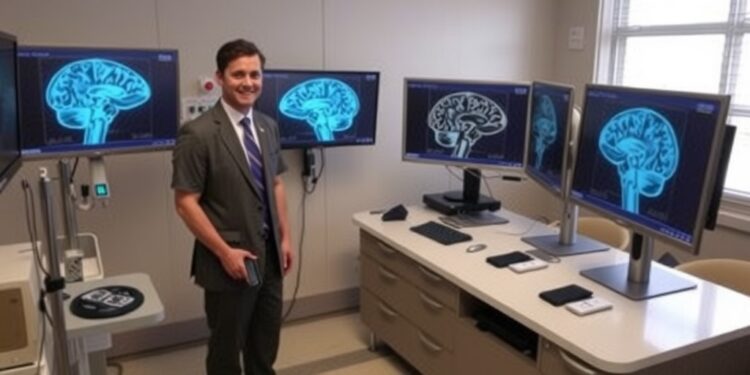Groundbreaking advances in the field of neurology have emerged from the University of Texas Health Science Center at San Antonio, where a pioneering approach to deep brain stimulation (DBS) is being implemented. The innovative configuration involves a system that adapts continuously to a patient’s symptoms, making it one of the first of its kind in the United States. This system, which debuted on March 25, 2025, holds the potential to revolutionize treatment for individuals suffering from debilitating movement disorders, such as Parkinson’s disease, dystonia, epilepsy, and essential tremors.
Deep brain stimulation is a well-established methodology that involves implanting electrodes within specific areas of the brain. These electrodes are wired to a battery-operated device, functioning similarly to a pacemaker, positioned in the chest. The stimulation delivered via these electrodes produces a targeted impulse of electricity to alleviate symptoms that significantly impair a patient’s life. While DBS has been FDA-approved since 1998, the treatment traditionally required manual adjustments during clinic visits. This longstanding requirement posed challenges for both doctors and patients because it limited the immediacy and adaptability of treatment based on rapidly changing symptoms.
Unlike its predecessors, the recent adaptive DBS technology developed by Medtronic represents a significant leap forward. The device features a sensor that continuously monitors the patient’s symptoms and adjusts the electrical impulses autonomously, thereby optimizing treatment in real time. The excitement surrounding this technology lies in its individualized approach to therapy. The adaptability means that stimulation can be finely tuned to the patient’s current state, rendering the treatment highly personalized rather than a standardized protocol.
Dr. Okeanis Vaou, a key figure in this initiative and a clinical associate professor, elaborates on the implications of this innovation. According to her, the device will automatically augment stimulation when symptoms escalate, such as tremors in Parkinson’s patients, and scale back during periods of symptom relief. This dynamic response system significantly enhances patient quality of life by ensuring that therapy is delivered precisely when it is needed, rather than relying on set intervals established during previous consultations.
The team at UT Health San Antonio, including Dr. Vaou and her fellow clinical assistants—Dr. Pablo Coss, Dr. Leila Saadatpour, and Dr. Sarah Horn—has been recognized as a leader in the field for its extensive experience with DBS technologies. They were selected by Medtronic as one of the first 24 sites across the nation to implement this groundbreaking adaptive DBS system. The consideration of their service capabilities indicates a sharp commitment to advancing patient care through state-of-the-art technology.
In this inaugural week of usage, the team activated the device for the first of seven patients who are expected to benefit from this sophisticated technology. The procedure, which is designed to take place during routine office visits, typically requires about 20 minutes to an hour. This accessibility could foster greater patient engagement and treatment adherence, allowing for a more hands-on approach to their care.
Dr. Alexander Papanastassiou, foremost in the surgical aspect of implementing DBS devices at University Hospital, plays a critical role in the operation. He notes a transformative improvement in the autonomic capabilities of the newly introduced system, contrasting it with earlier, non-adaptive devices. Prior iterations required periodic human intervention for recalibration based on downloaded data indicating brain activity. However, with the advent of the adaptive model, such manual adjustments become obsolete as the device now self-regulates based on real-time feedback from the patient’s neurological status.
The outcomes anticipated from this new system are backed by preliminary studies indicating not only effective symptom management but also a marked enhancement in overall patient quality of life. As Dr. Vaou mentioned, the continuous adaptation of stimulation correlates closely with immediate symptomatic changes, providing a seamless treatment experience. The prospect of patients experiencing fewer peaks and valleys in their symptoms is an alluring advantage of this technology, one that could lead to more stable lives for those grappling with chronic movement disorders.
Such innovative technologies are vital, especially considering that previous DBS devices often necessitated battery replacements every three to four years. With the introduction of rechargeable options capable of lasting up to 15 years, as demonstrated in past implementations, patients previously subjected to interruptions in treatment will witness a more consistent therapeutic regimen.
The movement disorders division at UT Health San Antonio was further distinguished when it became a recognized Parkinson’s Foundation Comprehensive Care Center, a prestigious designation that underscores its commitment to delivering superior patient care across a wide geographic area. This accolade is a testament to their ongoing efforts to improve patient management strategies and elevate the standards of neurological care.
Another intriguing facet of this advancement is its intersection with cutting-edge research initiatives. The Glenn Biggs Institute for Alzheimer’s and Neurodegenerative Diseases partners with UT Health San Antonio to explore the ramifications of adaptive systems in therapeutic environments. Such collaborations not only enhance research capacity but also translate cutting-edge scientific findings into practical, life-enhancing treatments for patients.
In summary, the adaptive DBS technology represents an extraordinary development in the treatment of movement disorders, marking a significant milestone for patients and healthcare providers alike. By streamlining the therapy delivery process and personalizing treatment regimens in real-time, this novel system underscores the future direction of neurology, integrating interconnectedness and responsiveness into patient care.
As the medical community eagerly anticipates the results and effectiveness of this approach, the hope remains that improved patient outcomes will soon be evident. For those living with the impacts of movement disorders, this breakthrough offers a glimmer of hope for a more manageable and fulfilling life.
Subject of Research: Neurological Innovations in Deep Brain Stimulation
Article Title: Adaptive Deep Brain Stimulation Technology Revolutionizes Movement Disorder Treatment
News Publication Date: March 31, 2025
Web References: https://uthscsa.edu
References: FDA and Medtronic approvals, clinical studies on adaptive DBS technology
Image Credits: University of Texas Health Science Center at San Antonio
Keywords
Movement disorders, Deep brain stimulation, Adaptive systems, Parkinson’s disease, Neurodegenerative diseases, Neurologic health advancements.




